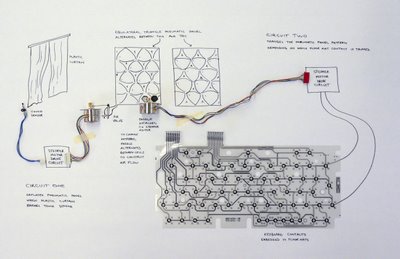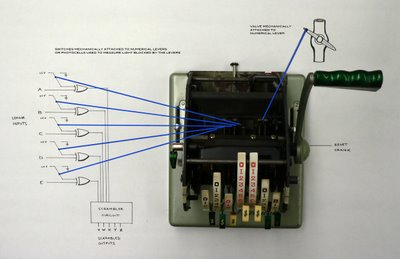The first is the "Equilateral Typewriter." This mechanism would provide an articulation in a pneumatic panel surface which changes over time and in response to people walking around the panel.

This mechanism is designed to interact with RPI's equilateral triangle pneumatic panel, which has the possibility of configuring itself into different hexagon patterns depending on which air cell is inflated first. A touch sensor, possibly triggered by someone pushing aside a plastic curtain, would partially deflate the panel by opening a valve. The typewriter's keyboard contacts would be placed into floor mats around the panel. A paddle or some other device that could constrict an air cell would be attached to a stepper motor (activated by the floor mat sensors). The paddle would be used to constrict one of two cells, depending on which floor mat sensor was activated. It is hoped that this constriction control would allow the panel to alternate between two different hexagon patterns. The panel would inflate again after some period of time, into the hexagon pattern determined by the action of someone walking over the floor mat sensors. The mechanism could be modified to interact with other types of pneumatic structures as well.
The "Paymaster Enigma" would be used to scramble sensor inputs and redirect them to various mechanisms. This device could take input from any sensor in the entire installation and redirect it to one or more devices. This could add to the theatrical quality of the installation, since the outcome of a sensor interaction would not be easily predictable.

The mechanism is inspired by the Enigma code machine used by Germany to encrypt communications during World War II. The numerical levers of the cheque imprinter would be interfaced with switches or photocells. A circuit would be used to scramble the sensor inputs based on the positions of the numerical levers. The crank of the cheque imprinter would be used to reset the levers.
A variable resistor could also be mechanically attached one of the numerical levers. This could be used by a circuit to control the intervals between when certain pneumatic structures are deflated or inflated. For example, when a lever is at its lowest position, a structure could be set to deflate every 20 minutes. With the lever at its highest position, it may deflate every 20 seconds.
My accordion is here at the bus depot, waiting to be picked up. I will begin to experiment with it tomorrow. I'm hoping that tubes could be attached to the accordion to capture the air moving in and out of the instrument. The air could be redirected to a small air cell that could move a pneumatic door or panel. It might be possible to hook up tubes to many parts of the installation, so that the accordion could be used to "play" the architecture.
No comments:
Post a Comment